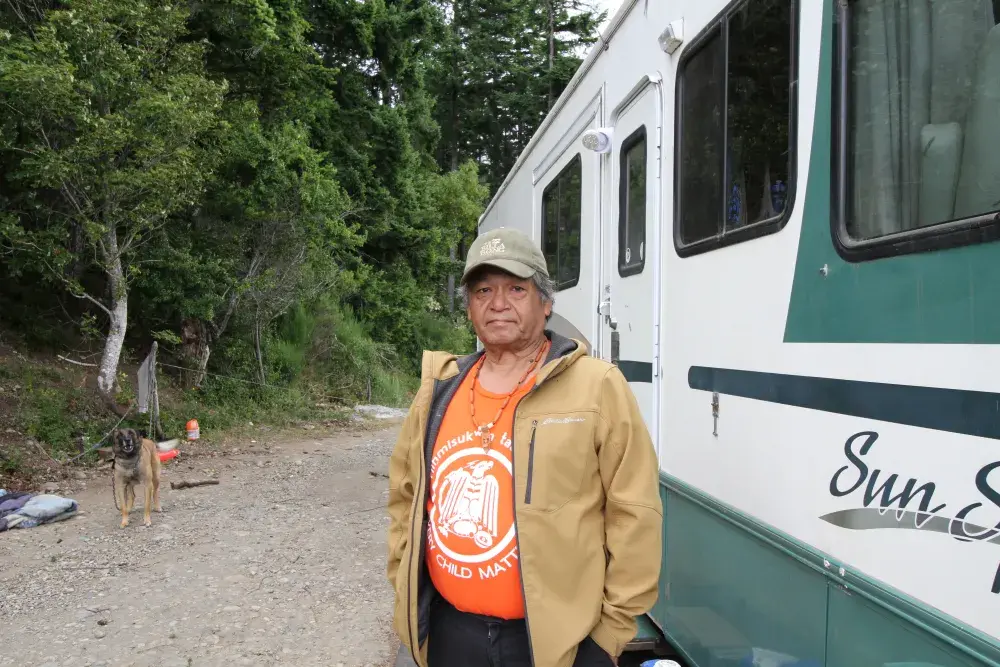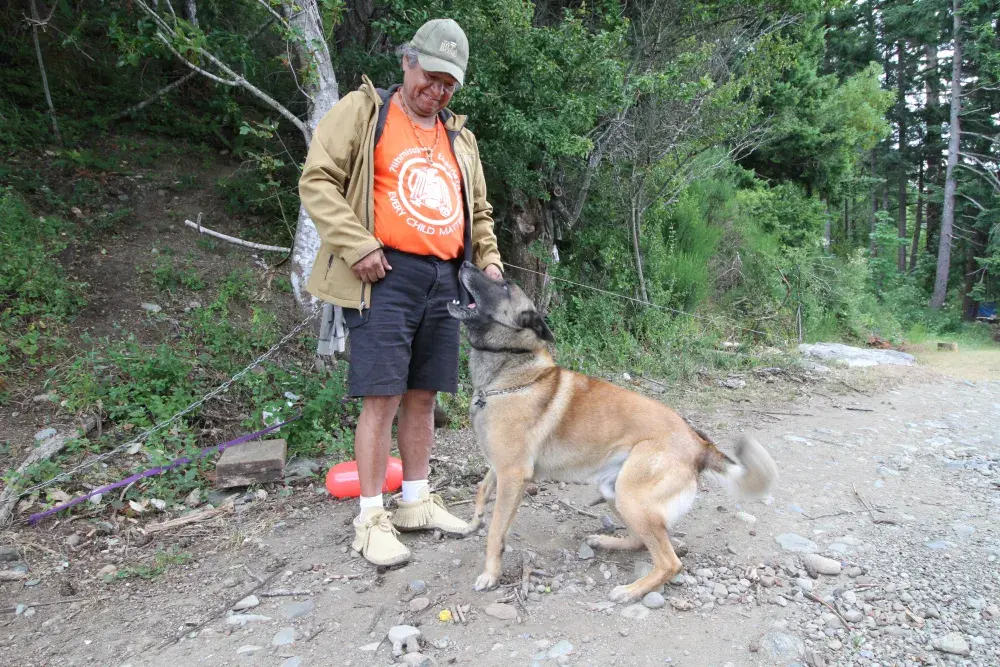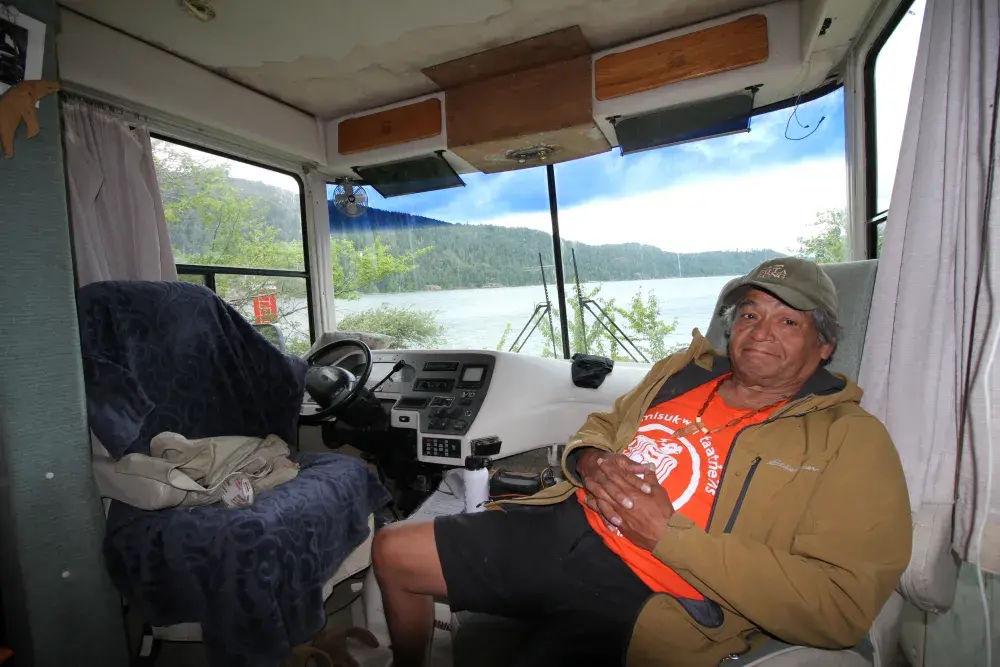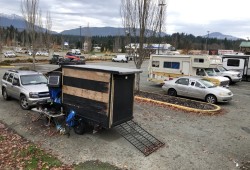In mid August the Mount Underwood forest fire erupted south of Port Alberni, sending a mushroom cloud over the community with a current of fear that residents of the small Vancouver Island city might be at risk of losing their homes. The city’s south-end neighbourhood of Cameron Heights was put on evacuation alert, along with the Tiipis Tseshaht reserve at Polly’s Point.
Although this was not an order to evacuate, as a precaution the reserve’s few residents temporarily moved elsewhere to be at a safer distance from the forest fire. But Joe Williams stayed, concerned he might not be able to return to the motor home he has lived in at the waterfront site for the past few years.
“I moved back home a couple of years ago. I’ve got nowhere else to go,” says the 63-year-old Tseshaht member. “I can’t park in anybody’s house, this is the only place I call home.”
On a summer afternoon Williams sits at the helm of the RV bus that has become his home. From his seat the vehicle’s long corridor leads to the bedroom, an expanse lined with the remnants of day-to-day life: coffee cups, papers, tools, framed family photos, stacks of DVDs and a bowl of dried food for his dog Zeus, a sturdy three-year-old Belgian Malinois Williams has had since he was a puppy.
Williams bought the motor home three years ago from a friend.
“A friend of mine sold it to me for a decent price. I paid it off in payments, which was nice,” he explains. “I came from Vancouver. I was going through a hard time over there and lost my housing. I went through a hard spell and decided I just needed to come home.”
Joe’s connection to the waterfront site runs deep. He recalls time there as a child, when his grandmother Cecilia Williams lived in a shack with an outhouse.
“Most of the people lived in houses that were on stilts down here,” he recalls.
Joe even stayed in an army tent at the site one winter in the 1990s to work on tearing down the old Alberni Plywood mill. That former industrial site has now become Canal Beach, which is right next to the Tiipis Tseshaht reserve.
“I’m down here, people leave me alone,” reflects Joe. “Nobody bothers me. It’s peaceful down here, it’s quiet.”
Trailer living prohibited on reserves
A pebbled beach stretches along the shore on the other side of Joe’s RV, where the bush opens to the exposed air of the Alberni Inlet. To the south the industrial bones of Port Alberni’s waterfront extend into the distance, part of a territory the Tseshaht First Nation has called home for countless generations. The Tseshaht and Hupacasath, who also are based in the Alberni Valley, continue to rely on their territorial resources – particularly the annual migration of several salmon species that return to the Somass river each year, supporting a fishery that engages a large proportion of the local First Nation community.
But as a modern Indigenous community the Tseshaht’s management responsibilities over its reserve land includes the enforcement of policies, one of which disallows people to permanently live in RVs and trailers.
This led to a letter Joe received from the First Nation in September 2023, which cites “numerous concerns and complaints with respect to your camp related to safety and health risks.” The letter acknowledges Joe’s deep ancestral connection to the area, but stresses that Tseshaht’s housing, health and safety policies must be followed.
“As you are aware, we are in a campfire ban, not just in our territory, but throughout much of B.C.,” reads the letter, which was issued amid the worst forest fire season in the history of British Columbia. “The area does not have the necessary infrastructure to support a camp of this nature, including a fire hydrant to deal with firefighting. Overall, the camp, so constructed, results in unsafe living conditions, not only for yourself, but also for the permanent residents in the area and our territories.”
“It’s Tseshaht council’s fiduciary duty to look after the legal interests of the nation,” explained Tseshaht Chief Councillor Ken Watts regarding people living in motor homes on the reserves. “If something ever happens we want to make sure that the individual and the community are covered for liability, that everything is all taken care of from an insurance perspective. One of biggest pieces that we’re facing now is we have parts of our community that aren’t serviced by water, so we don’t have fire hydrants in some of these locations.”
Watts admits that the rapid spread of the Mount Underwood wildfire in August presented a frightening scenario for the First Nation, reinforcing the need to prevent forest fires from sparking during drought conditions that have become an annual occurrence in the Alberni Valley.
“Any RV that’s not hooked up properly, one small incident could have sparked a forest fire,” says the elected chief. “We’re not looking to throw anybody out, but we have to look out for the safety of the community too.”
Elsewhere in the Alberni Valley, the Hupacasath First Nation also prohibits people from permanently living in RVs and trailers on reserve land. This is only possible when a member has a certificate of possession for a piece of land and needs to live in the trailer temporarily.
“If they have a possession on the land, they are able to move in a trailer and do whatever they want on their land, within reason,” explains Hupacasath Councillor Jared Dick. “They have to make sure they have water and electrical hook ups.”
Dicks adds that a certificate of possession is only granted if the Hupacasath member can show the means to build a permanent structure on the land, making the trailer option strictly temporary for those on reserve.
Scarce on reserve housing
Meanwhile a housing shortage persists in the Alberni Valley. According to a housing report presented to Port Alberni city council last December, the average price of house has gone up 52 per cent since 2020, while condominiums have increased by 117 per cent. Rental prices have also escalated, outpacing gains in income by 33 per cent in the area. This means that Port Alberni needs to have at least another 1,200 homes built by 2030 to meet this growing demand for shelter, states the report.
On reserves housing is also scarce, causing long wait lists for the Hupacasath First Nation.
“We have three housing wait lists,” said Dick, referring to the lineups for social supportive housing, rentals and property possession certificates. “Some people have been on those waiting lists for a really, really long time.”
On reserve housing operates under Indigenous Services Canada, and this reliance on the federal department requires a pre-feasibility study, plus two more assessments, explains Dick.
“Each study you need for ISC takes upwards of two years, so by the time they’re all done, getting everything developed and paid for, it’s six years down the line,” he says, noting that Hupacasath has tried to speed up this process by doing the feasibility studies themselves.
The First Nation’s main reserve in Port Alberni’s municipal boundaries is almost full, leading Hupacasath to clear lots on the Klehkoot reserve two kilometres west of the city.
“Ahahswinis is almost fully developed, so now we have to seek our other reserves, which are much further away for development,” says Dick.
On the Tseshaht reserve there are currently just four unoccupied homes, all of which are deemed unsafe to live in and are owned by members who have dwellings elsewhere, according to the First Nation’s housing department. In hopes of catching up with the housing demand, Tseshaht has even invested in property outside of its reserve land, purchasing a parking lot by the now-closed Alberni Pacific Division sawmill for a future development. Announced in the spring of 2024, the acquisition of the 7.9-acre lot was made possible by a $5-million grant that came from the provincial government the previous year.
The First Nation is also looking into opening an RV park, something that the community has needed for years. This park would have water and hopefully sewer connections for those living in motor homes, says Watts.
“Our staff are doing feasibility work on at least one location now, just making sure that we have water servicing,” he says. “We don’t want to make anybody homeless.”
“We’ve made it really clear that individuals need to work with the nation,” adds Watts. “We’ve made some amendments to try and help people, because we know the cost of living is high, rent is high.”
Joe Williams says his First Nation told him in the past that elders’ housing was becoming available, but he wouldn’t be able to bring his dog. Joe can’t imagine living without Zeus, a companion who helps with his anxiety, which Joe admits he is taking medication for.
For over 20 years Joe had a career as a long-haul mover, travelling “all over Canada”, but he’s currently supported by a pension, social assistance and any money he can make.
“Right now I’m just getting money when I can, getting by,” says Joe.
“I lost a girlfriend a couple of years ago. Lost her to drugs, she ODed in Vancouver,” he recalls. “I tried to help her. That’s the reason why I got the motor home, so we could have a place to call home.”
Varied reasons for homelessness
The issue of people living in motor homes and trailers is not unique to the Alberni Valley’s First Nation reserves. For years the city tried remove a community of trailers from a property on 4th Avenue, an empty lot that was cleared after a fire destroyed a low-rent apartment building in July 2013. Dozens of trailers were set up on the property, where the landlord reportedly charged $375-500 in monthly rent for those needing shelter.
Deemed unsafe and a violation of municipal bylaws, in November 2020 the city and fire department issued a remedial action requirement that the trailers be removed. But this didn’t happen until three years later, when tenants in the trailers had safe shelter available next door with the opening of the Wałyaqił Tiny Home Village, a fully staffed collection of small units for marginalized residents run by the Port Alberni Friendship Center.
A disproportionately high number of Port Alberni’s homeless continue to be Indigenous, according to a point-in-time count conducted on April 30 by the province and the BC Association of Aboriginal Friendship Centres. On that day 49 per cent of respondents identified as Indigenous, while just 15 per cent of Port Alberni’s population are classified as Aboriginal in the most recent census data. Of these Indigenous respondents, 82 per cent reported having lived in the community for more than a year, while 53 per cent had been in the foster care system during their youth.
Of all that were surveyed, the reasons for housing loss were varied. Thirty-two percent cited not enough income, 24 per cent attributed homelessness to substance use and 17 per cent said they had to leave their past housing because of unlivable conditions.
“An experience of homelessness is almost always the result of more than one event,” states the homeless count report. “Often, income challenges are pushed to a crisis by an event, such as a health challenge, relationship change, or eviction.”
Addictions and mental health
One day in the middle of December Joe Williams was confronted with the state of Port Alberni’s homelessness issue, when he saw a man sleeping on the ground by the former Zeller’s building in the uptown area.
“There’s four inches of snow on the ground, he’s laying there shivering,” says Joe. “I got out of my car, gave him my coat, came back down here and got a sleeping bag for him.”
He’s personally seen that the path to homelessness is complex.
“Before the drug epidemic with crack and meth and all this stuff, people always had a couch to go sleep on, people always had a home to go to,” he continues. “That’s gone now, they don’t have that anymore, because they’re sick. They’re sick with addictions or mental health.”
He admits to not responding well to rules or being told how to live, but hopes a solution can be found to his current dilemma.
“I want to make this my forever home,” says Joe. “You start to think differently about life when you’ve got more years behind you than you have ahead of you. That’s where I’m at.”
*With files from Holly Stocking






